Hypertonic saline - Study guides, Class notes & Summaries
Looking for the best study guides, study notes and summaries about Hypertonic saline? On this page you'll find 2923 study documents about Hypertonic saline.
Page 4 out of 2.923 results
Sort by
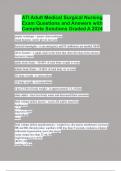
-
ATI Adult Medical Surgical Nursing Exam Questions and Answers with Complete Solutions Graded A 2024
- Exam (elaborations) • 158 pages • 2024
-
- $19.49
- + learn more
aseptic technique - means clean technique -hand hygiene, sterile gloves not used bacterial meningitis - is an emergency and IV antibitoics are needed ASAP stress fracture - a small crack in the bone that often develops from chronic, excessive impact adults body fluids - 50-60% of total body weight is water infants body fluids - 15-80% of total body wt is water 2/3 body weight - is intracellular 1/3 body weight - is extracellular 1 kg (2.2 lb) of body weight - is approximate...
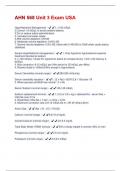
-
AHN 568 Unit 3 Exam USA (Questions + Answers) Solved
- Exam (elaborations) • 12 pages • 2024
- Available in package deal
-
- $8.39
- + learn more
HyperNatremia Management - ️️1. >145 mEq/L 2.Correct 1-2 mEq/L to avoid cerebral edema. 3.D/c or reduce saline administration. 4. Increase oral water intake. 5.Mild volume depletion: D5%W 6. Moderate volume depletion: 0.45% NS 7. Severe volume depletion: 0.9% NS; follow with 0.45%NS or D5W when cardio status stabilized. Severe HypoNatremia management - ️️1. Only hypotonic hyponatremia requires treatment directed at sodium. 2. (<120 mEq/L): infuse 3% hypertonic saline to i...

-
CNUR 203 midterm Questions with Complete Solutions
- Exam (elaborations) • 11 pages • 2024
-
- $15.49
- + learn more
Isotonic IV solution Correct Answer--NS, LR -expand intravascular and extracellular fluid -most common Hypotonic IV solution Correct Answer--.45 Saline -osmosis of fluid into the cell Hypertonic IV solution Correct Answer--3% Saline, 5% dextrose -moves intracellular fluid into vasculature Plasma expanded IV solution Correct Answer--albumin, plasma -stay in the vascular space and increase the osmotic pressure Lab work for dyspnea and edematous lower legs Correct Answer--CBC -el...
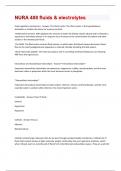
-
NURA 408 fluids & electrolytes Exam Questions With 100% Correct Answers.
- Exam (elaborations) • 19 pages • 2024
- Available in package deal
-
- $8.39
- + learn more
Fluid regulation mechanisms - Answer--The thirst center. The thirst center in the hypothalamus stimulates or inhibits the desire for a person to drink. -Antidiuretic hormone. ADH regulates the amount of water the kidney tubules absorb and is released in response to low blood volume or in response to an increase in the concentration of sodium and other solutes in the intravascular fluids. -The RAAS. The RAA system controls fluid volume, in which when the blood volume decreases, blood flow t...

-
NBRC TMC Exam Review (Latest 2024/ 2025 Update) Questions and Verified Answers| 100% Correct| Grade A
- Exam (elaborations) • 66 pages • 2024
- Available in package deal
-
- $10.99
- + learn more
NBRC TMC Exam Review (Latest 2024/ 2025 Update) Questions and Verified Answers| 100% Correct| Grade A Q: What position would you place pt for CXR for TB? Answer: Apical lordotic Q: On a lateral neck CXR, a steeple sign would indicate what? Answer: Croup Q: On a lateral neck CXR, a thumb sign would indicate what? Answer: Epiglottitis Q: What pathology has fluffy infiltrates, butterfly pattern or batwing pattern on CXR?? Answer: Pulmonary edema Q: What is the t...
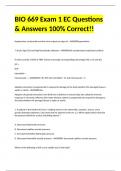
-
BIO 669 Exam 1 EC Questions & Answers 100% Correct!!
- Exam (elaborations) • 58 pages • 2024
-
- $13.99
- + learn more
Hypotension, tachycardia and low urine output are signs of - ANSWERhypovolemia 7.36 ph, high CO2 and high bicarbonate indicates - ANSWERfully compensated respiratory acidosis If water consists of 60% of TBW. Choose and assign corresponding percentages (40, 5,15 and 20). ICF = ECF= Interstitial = Intravascular = - ANSWERICF=40; ECF=20; Interstitial = 15 and Intravascular = 5 Adaptive Immunity is programmed to respond to damage to the body whether the damaged tissue is septic or steri...
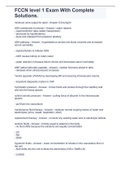
-
FCCN level 1 Exam With Complete Solutions.
- Exam (elaborations) • 13 pages • 2022
-
- $13.99
- 6x sold
- + learn more
minimum urine output for adult 0.5mL/kg/hr ADH (antidiuretic hormone) - water retainer - vasoconstrictor (also called Vasopressin) - produced by hypothalamus - store and released from posterior pituitary ADH pathway - hypothalamus senses low blood volumed and increased serum osmolality - signal pituitary to release ADH - ADH causes kidney to retain water - water retention increases blood volume and decreases serum osmolality ANP (atrial natriuretic peptide) -...
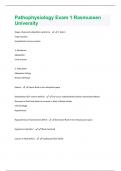
-
Pathophysiology Exam 1 Rasmussen University (Quizzes With Correct Ans) Already Passed!!
- Exam (elaborations) • 28 pages • 2024
- Available in package deal
-
- $7.99
- + learn more
Stages of general adaptation syndrome - 1. Alarm Initial reaction Sympathetic nervous system 2. Resistance Adaptation Limit stressor 3. Exhaustion Adaptation failing Disease develops Edema - Excess fluid in the interstitial space Dehydration (ECF volume deficit) - Can occur independently without electrolyte defects Decrease in fluid level leads to increase in level of blood solutes Cell shrinkage Hypotension Hypovolemia or fluid volume deficit - Decreased fluid in the intravascular...
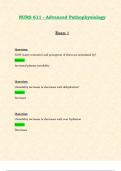
-
NURS 611 / NURS611 Exam 1 (Latest 2024 / 2025 Update): Advanced Pathophysiology | Complete Guide with Questions and Verified Answers | 100% Correct | Grade A - Maryville
- Exam (elaborations) • 43 pages • 2024
- Available in package deal
-
- $7.99
- + learn more
Exam 1: NURS611 / NURS 611 (Latest 2024 / 2025 Update) Advanced Pathophysiology Exam Review | Complete Guide with Questions and Verified Answers | 100% Correct | Grade A - Maryville Q: ADH (water retention) and perception of thirst are stimulated by? Answer: Increased plasma osmolality Q: Osmolality increases or decreases with dehydration? Answer: Increases Q: Osmolality increases or decreases with over hydration Answer: Decreases Q: What is a normal sodium level? Answer: 135-145 meq/l Q: Sodium...
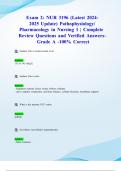
-
Exam 2: NUR 3196 (Latest 2024- 2025 Update) Pathophysiology/ Pharmacology in Nursing 1 | Complete Review with Questions and Verified Answers- Grade A -100% Correct
- Exam (elaborations) • 77 pages • 2024
- Available in package deal
-
- $11.49
- + learn more
Exam 2: NUR 3196 (Latest Update) Pathophysiology/ Pharmacology in Nursing 1 | Complete Review with Questions and Verified Answers- Grade A -100% Correct Q: Sodium (Na+) normal serum level Answer: 135 to 145 mEg/L Q: Sodium (Na+) roles Answer: - Regulates osmotic forces (water follows sodium) - nerve impulse conduction, acid-base balance, cellular biochem, membrane support Q: What is the primary ECF cation Answer: sodium Q: Isovolemic (euvolemic) hypern...

That summary you just bought made someone very happy. Also get paid weekly? Sell your study resources on Stuvia! Discover all about earning on Stuvia


